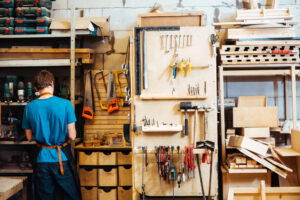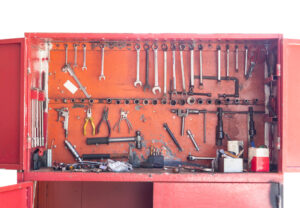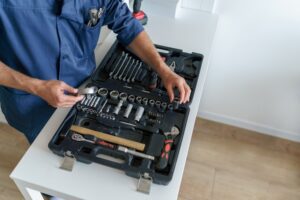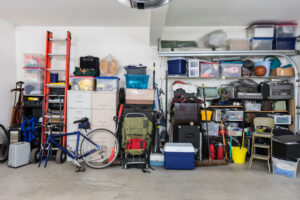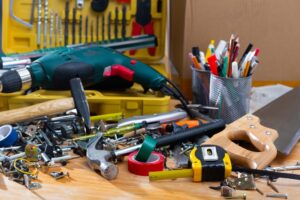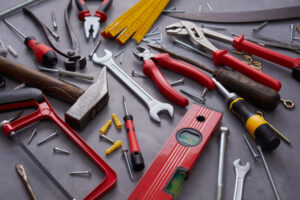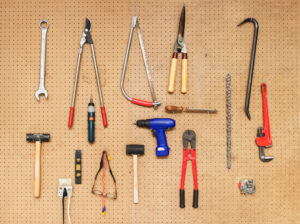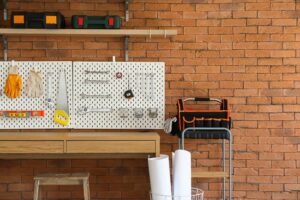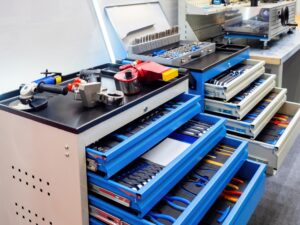If you work with a lot of tools, you know how quickly they can become disorganised. Whether you’re a mechanic, carpenter, or homeowner, having a well-organised tool chest is essential for an efficient workspace.
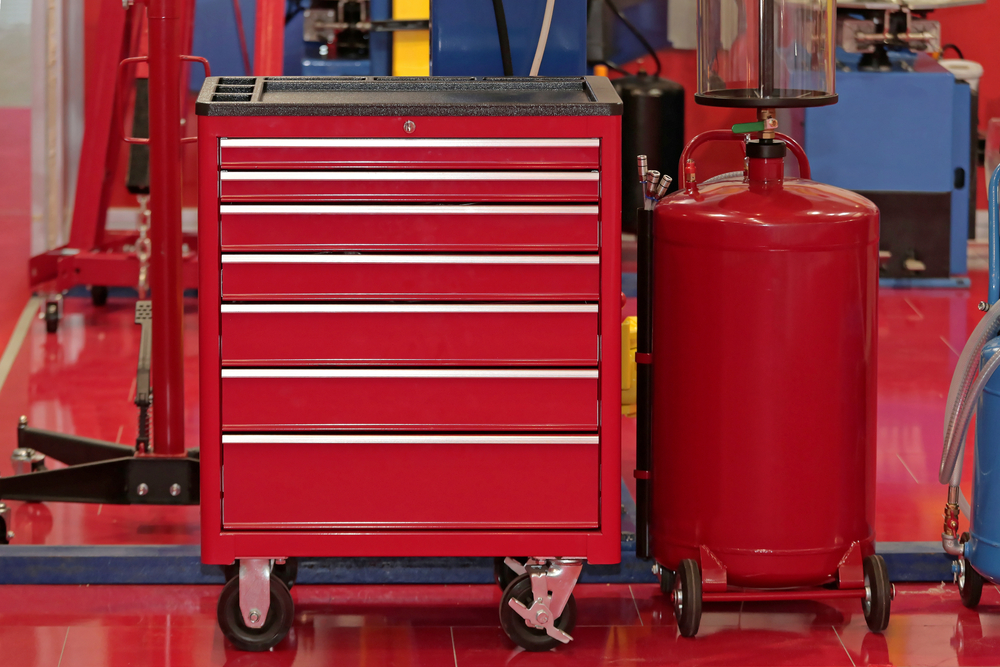
Customising your tool chest organisation is key, and using foam inserts is a popular method. By cutting foam to fit your tools and creating a layout that maximises space, you can easily find and access your tools. Shadow foam boards are also a great tool chest organisation hack, as they allow you to quickly identify missing tools. Cutting foam can be done with a utility knife or foam hot knife.
Additionally, creating semicircles or strips in the foam can make it easier to pick up tools. Don’t forget to consider the size and depth of the foam when organising larger tools like drills, and make sure to plan and measure before cutting. Finally, using a tape measure to find the exact sizes of your drawers and purchasing a large foam sheet or kit can save you money when organising multiple drawers.
Key Takeaways:
- Customise your tool chest organisation using foam inserts.
- Utilise shadow foam boards to quickly identify missing tools.
- Create semicircles or strips in the foam to make it easier to pick up tools.
- Consider the size and depth of foam when organising larger tools.
- Measure your drawers and purchase the right foam sheet or kit for multiple drawers.
Types of Tool Box Organisation
When it comes to organising your toolbox, there are different types of tool storage options that you can consider. Each option offers unique benefits and is suitable for different tool collections and preferences. Let’s explore some of the popular tool storage ideas:
1. Portable Tool Boxes
Portable toolboxes are versatile and come in various sizes, making them a popular choice for many DIY enthusiasts and professionals. These toolboxes are lightweight, easy to carry, and provide convenient storage for a range of tools. They are ideal for those who need to transport their tools to different job sites or work in multiple locations.
2. Tool Bags
If you primarily work with small hand tools, a tool bag might be the perfect solution for you. Tool bags typically have numerous pockets on the outside, allowing you to easily access and organise your tools. They are particularly useful for tradespeople who use a multitude of small tools on a regular basis.
3. Tool Chests
Tool chests offer a larger storage capacity and are commonly used by mechanics or those with extensive tool collections. These chests usually have multiple drawers and compartments, providing ample space for organising and storing various tools. Tool chests are sturdy and durable, making them suitable for heavy-duty use.
| Tool Storage Option | Key Features |
|---|---|
| Portable Tool Boxes | – Versatile and easy to carry – Available in various sizes – Suitable for transporting tools – Lightweight and durable |
| Tool Bags | – Multiple pockets for small tools – Convenient and easy to access – Ideal for tradespeople with small hand tools – Portable and compact |
| Tool Chests | – Larger storage capacity – Multiple drawers and compartments – Sturdy and durable construction – Suitable for heavy-duty use |
Tool Box Organisation Tips
When it comes to the organisation of your toolbox, implementing a few tips and tricks can make a significant difference. Here are some tool chest organisation hacks to help you transform your cluttered toolbox into a well-organised workspace.
Assess Your Tool Storage Needs
Before you start organising your tools, take some time to assess your tool storage needs. Consider the types and sizes of tools you have and how frequently you use them. This will help you determine the most efficient way to arrange and store your tools.
Utilise Vertical Storage Options
Maximise the available space in your toolbox by utilizing vertical storage options such as pegboards or magnetic strips. These allow you to hang tools and keep them easily accessible. Vertical storage is particularly useful for tools with long handles, such as screwdrivers or pliers.
Divide and Conquer with Drawers
If your toolbox has drawers, make use of dividers to create separate compartments for different types of tools. This will help prevent smaller items from getting mixed up and make it easier to find what you need. Consider organising tools based on their functions, such as separating screwdrivers from wrenches or drill bits from sandpaper.
Create Custom Labels
To quickly identify the contents of each storage area, create custom labels for your tool box. You can use adhesive labels, tape, or even a label maker to mark the sections or compartments.
| Tool Organisation Tip | Description |
|---|---|
| Use Foam Inserts | Cut foam to fit your tools and create a layout that maximises space. This helps keep your tools secure and easily accessible. |
| Arrange Tools for Easy Pick-Up | Organise your tools in a way that allows you to pick them up easily. Alternating the handle directions of your tools and creating designated spaces for cords and batteries can save you time. |
| Consider Vertical Storage | Utilise vertical storage options like pegboards or magnetic strips to maximise space and keep tools easily accessible. |
| Create Custom Labels | Use labels to quickly identify the contents of each storage area. This saves time and ensures everything is in its proper place. |
Tool Box Organisation Ideas for Specific Trades
When it comes to toolbox organisation, different trades require different approaches. Here are some effective toolbox organisation ideas for specific trades:
Automotive Tool Box Organisation
For automotive professionals, organisation is key to a smooth and efficient workflow. Consider using a magnetic tray to keep small metal parts secure and easily accessible. Designate specific spots for tire gauges and pressure gauges to ensure they are always in the right place. When organising your wrenches, arrange them by size so you can quickly find the one you need.
Carpentry Tool Box Organisation
For carpenters, having a well-organised toolbox is essential for easy access to frequently used tools. Keep your saw blades in a designated area to protect them from damage and ensure they are readily available. Consider using a tool belt or apron to keep frequently used hand tools within reach. Storing sandpaper in a labelled container will save you time when searching for the right grit.
Plumbing Tool Box Organisation
Plumbers deal with a variety of fittings and pipes, so it’s crucial to keep everything organised. Use a pipe cutter holder to keep your pipe cutter secure and easily accessible. Label containers for different types of fittings to quickly find what you need. Store PVC pipes and fittings in a labelled container to avoid confusion and save space.
Electrical Tool Box Organisation
Electricians require precise tools and organised storage for their work. Keep your wire strippers and cutters in a designated area so you can easily find them when needed. Utilise wire spool holders to keep your spools organised and prevent tangling. Designate a spot for lockout/tagout supplies to ensure easy access and promote safety.
Manufacturing Tool Box Organisation
In the manufacturing industry, efficiency is crucial, and having an organised toolbox can help streamline operations. Use parts trays to keep small components and fasteners sorted and easily accessible. Keep your calipers in a designated spot for accurate measurements. Label containers for different types of fasteners and connectors to maintain an organised work environment.
| Trade | Use a magnetic tray, designate spots for tire and pressure gauges, and arrange wrenches by size |
|---|---|
| Automotive | Use a pipe cutter holder, label containers for different fittings, store PVC pipe and fittings in a labelled container |
| Carpentry | Keep saw blades in a designated area, use a tool belt or apron, and store sandpaper in a labelled container |
| Plumbing | Designate a spot for wire strippers and cutters, use wire spool holders, and store lockout/tagout supplies in a designated spot |
| Electrical | Designate a spot for wire strippers and cutters, use wire spool holders, store lockout/tagout supplies in a designated spot |
| Manufacturing | Utilise parts trays, keep calipers in a designated spot, label containers for different fasteners and connectors |
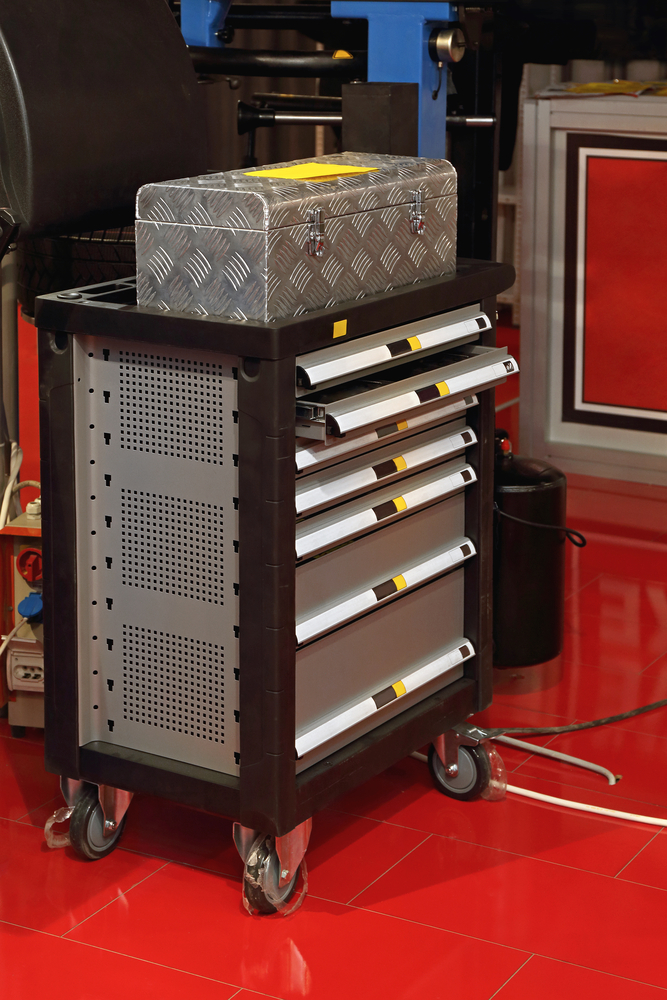
Common Tool Box Organisation Mistakes to Avoid
When it comes to organising your toolbox, there are a few common mistakes that you should avoid.
One of the biggest mistakes is overcrowding your toolbox. When you try to cram too many tools into a small space, it not only makes it difficult to find what you need, but it can also lead to damage and disorganisation. Instead, consider using a larger toolbox or separate boxes for different tool categories, allowing for easier access and a more organised system.
Another mistake is mixing tool categories. If you don’t separate your tools by category, it can become challenging to find specific tools when you need them. To avoid this, use dividers or foam inserts to keep your tools organised by type.
| Use a larger toolbox or separate boxes for different tool categories | How to Avoid Them |
|---|---|
| Overcrowding the tool box | Overcrowding the toolbox |
| Mixing tool categories | Separate tools by category and use dividers or foam inserts to keep them organised |
| Not securing tools properly | Use tool organisers, trays, or foam inserts to keep tools secure during transport |
Lastly, maintaining regular organisation and cleaning of your toolbox is essential. Neglecting to do so can quickly lead to clutter and make it difficult to find tools when you need them. Set aside time regularly to assess and organise your toolbox, ensuring that everything is accounted for and in its proper place. Consider implementing a colour-coding system or using customisable labels and tags to quickly identify and locate tools.
Conclusion
Organising your tool chest is a crucial step in creating an efficient and safe workspace. By customising your toolbox organisation, considering different types of tool storage options, and utilising organisation tips and hacks, you can easily find and access your tools.
Avoiding common toolbox organisation mistakes and regularly cleaning and maintaining your toolbox will ensure the longevity and effectiveness of your tools. Whether you’re a DIYer or a professional, a well-organised toolbox is essential for streamlining your projects and maximising your productivity.
Take the time to organise your tool chest today and enjoy the benefits of an efficient workspace.
FAQ
How can I customise my tool chest organisation?
One popular method is using foam inserts. By cutting foam to fit your tools and creating a layout that maximises space, you can easily find and access your tools. Shadow foam boards are also a great tool chest organisation hack, as they allow you to quickly identify missing tools.
What tools can I use to cut foam?
You can use a utility knife or foam hot knife to cut foam for your tool chest organisation.
How can I make it easier to pick up tools from the foam?
Creating semicircles or strips in the foam can make it easier to pick up tools.
What should I consider when organising larger tools like drills?
When organising larger tools like drills, consider the size and depth of the foam. Plan and measure before cutting to ensure a proper fit.
How can I save money when organising multiple drawers?
Use a tape measure to find the exact sizes of your drawers, then purchase a large foam sheet or kit that can be cut to fit multiple drawers.
What types of tool storage options should I consider?
You can consider portable tool boxes, tool bags, and tool chests depending on the size and type of your tool collection.
How can I save time when searching for specific tools?
Store frequently used tools in easily accessible parts of the tool box and organise smaller tools in upper sections. Adding labels to your tool box can also help you quickly locate tools and maintain an organised system.
What are some organisation tips for different trades?
For automotive tool box organisation, use a magnetic tray and organise wrenches by size. In carpentry, keep saw blades in a designated area and store sandpaper in a labeled container. For plumbing, use a pipe cutter holder and label containers for different types of fittings. In electrical work, keep wire strippers and cutters in a designated area and use wire spool holders. For manufacturing, use parts trays and label containers for different types of fasteners and connectors.
What are some common tool box organisation mistakes to avoid?
Avoid overcrowding the tool box, as it can lead to damage and disorganisation. Separate tools by category and use dividers or foam inserts to keep them organised. Secure your tools to prevent them from becoming dangerous projectiles during transport. Follow safety measures and store hazardous materials properly. Regularly clean and organise your tool box to prevent clutter and ensure all tools are accounted for.
- Drill Battery Maintenance: Essential Tips for Cordless Drill Battery Care - February 5, 2024
- Troubleshooting Drill Issues - February 5, 2024
- Quick Drilling Techniques - February 2, 2024

